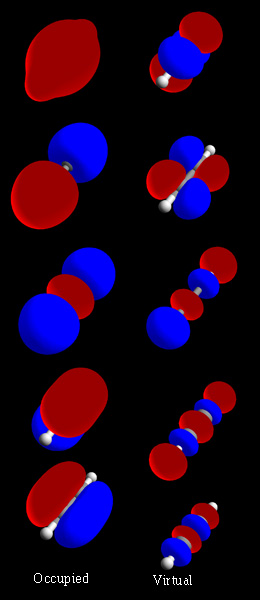|
Mallory Reaction
In organic chemistry, the Mallory reaction is a Organic photochemistry, photochemical-cyclization–Elimination reaction, elimination reaction of diaryl-ethylene structures to form phenanthrenes and other polycyclic form polycyclic aromatic hydrocarbons and heteroaromatics.Mallory, F. B.; Mallory, C. W. ''Org. React.'' 1984, ''30'', 1. This name reaction is named for Frank B. Mallory (chemist) , Frank Mallory, who discovered it while a graduate student. Under UV irradiation, stilbene and its derivatives undergo intramolecular cyclization to form dihydrophenanthrenes. In the presence of an oxidant, the dihydrophenanthrenes aromatize to give polycyclic aromatics. Typically, the dihydrophenanthrenes themselves are relatively unstable, and revert to ''cis''-stilbenes in the absence of a hydrogen-trapping agent. Suitably substituted stilbenes may undergo irreversible, rearomatizing elimination or [1,n]-shift processes in the absence of an oxidant. Aryl enynes, heteroatomic stilbene deri ... [...More Info...] [...Related Items...] OR: [Wikipedia] [Google] [Baidu] |
Organic Chemistry
Organic chemistry is a subdiscipline within chemistry involving the science, scientific study of the structure, properties, and reactions of organic compounds and organic matter, organic materials, i.e., matter in its various forms that contain carbon atoms.Clayden, J.; Greeves, N. and Warren, S. (2012) ''Organic Chemistry''. Oxford University Press. pp. 1–15. . Study of structure determines their structural formula. Study of properties includes Physical property, physical and Chemical property, chemical properties, and evaluation of Reactivity (chemistry), chemical reactivity to understand their behavior. The study of organic reactions includes the organic synthesis, chemical synthesis of natural products, drugs, and polymers, and study of individual organic molecules in the laboratory and via theoretical (in silico) study. The range of chemicals studied chemistry includes hydrocarbons (compounds containing only carbon and hydrogen) as well as compounds based on carbon, but a ... [...More Info...] [...Related Items...] OR: [Wikipedia] [Google] [Baidu] |
Molecular Orbital
In chemistry, a molecular orbital is a mathematical function describing the location and wave-like behavior of an electron in a molecule. This function can be used to calculate chemical and physical properties such as the probability of finding an electron in any specific region. The terms ''atomic orbital'' and ''molecular orbital'' were introduced by Robert S. Mulliken in 1932 to mean ''one-electron orbital wave functions''. At an elementary level, they are used to describe the ''region'' of space in which a function has a significant amplitude. In an isolated atom, the orbital electrons' location is determined by functions called atomic orbitals. When multiple atoms combine chemically into a molecule by forming a valence chemical bond, the electrons' locations are determined by the molecule as a whole, so the atomic orbitals combine to form molecular orbitals. The electrons from the constituent atoms occupy the molecular orbitals. Mathematically, molecular orbitals are an ... [...More Info...] [...Related Items...] OR: [Wikipedia] [Google] [Baidu] |
Scheme 7 Rev
Scheme or schemer may refer to: Arts and entertainment * ''The Scheme'', a BBC Scotland documentary TV series * The Scheme (band), an English pop band * ''The Scheme'', an action role-playing video game for the PC-8801, made by Quest Corporation * Schemer (comics), Richard Fisk, a Marvel Comics villain turned antihero * Horace Schemer, a fictional character in the TV series ''Shining Time Station'' * ''Schemers'' (film), a Scottish film Computing * Scheme (programming language), a minimalist dialect of Lisp * Scheme (URI), the front part of a web link, like "http" or "ftp" * Google Schemer, a former service allowing its users to share plans and interests Other uses * Classification scheme (information science), eg a thesaurus, a taxonomy, a data model or an ontology * Scheme (mathematics), a concept in algebraic geometry * Scheme (rhetoric), a figure of speech that changes a sentence's structure * Scam, an attempt to swindle or cheat people through deception * Scheme, a type of ... [...More Info...] [...Related Items...] OR: [Wikipedia] [Google] [Baidu] |
Triphenylene
Triphenylene is an organic compound with the formula (C6H4)3. It's a flat polycyclic aromatic hydrocarbon (PAH) that has a highly symmetric and planar structure consists of four fused benzene rings. Triphenylene has delocalized 18-''π''-electron systems based on a planar structure, corresponding to the symmetry group ''D''3h. It is more Resonance (chemistry), resonance stable than its isomers chrysene, Benz(a)anthracene, benz[''a'']anthracene, Benzo(c)phenanthrene, benzo[''c'']phenanthrene, and tetracene, hence resists hydrogenation. It is a light yellow powder, insoluble in water. Triphenylene serves as a fundamental building block in Discotic liquid crystal, discotic liquid crystals, where its planar, disc-like structure facilitates the formation of columnar mesophases, enabling applications in organic electronics. It's also being used as the base of covalent and metal organic frameworks. Discovery and First Synthesis Triphenylene was first separated by German Chemists H. Sc ... [...More Info...] [...Related Items...] OR: [Wikipedia] [Google] [Baidu] |


